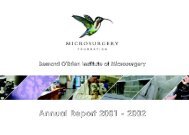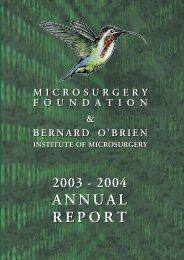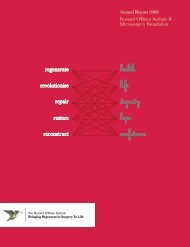annual report - O'Brien Institute
annual report - O'Brien Institute
annual report - O'Brien Institute
Create successful ePaper yourself
Turn your PDF publications into a flip-book with our unique Google optimized e-Paper software.
Barbara Walker Centre for Pain Management<br />
Bernard O’Brien <strong>Institute</strong> of Microsurgery<br />
Director<br />
Dr Andrew Muir<br />
I<br />
am pleased to<br />
<strong>report</strong> that<br />
significant<br />
progress has been<br />
made in the<br />
management and<br />
treatment of pain at<br />
the Barbara Walker<br />
Centre for Pain<br />
Management, in this<br />
our second full year<br />
of operation.<br />
The mission of the Centre is to provide<br />
specialist multi-disciplinary assessment and<br />
treatment services for the management of<br />
complex pain across all disciplines of medicine.<br />
Through its association with the Bernard<br />
O’Brien <strong>Institute</strong> of Microsurgery, the Barbara<br />
Walker Centre for Pain Management conducts<br />
medical research to improve clinical outcomes<br />
for acute pain sufferers.<br />
Research<br />
· Two posters presentations were submitted to<br />
the IASP’s 9 th World Congress on Pain in<br />
August 1999 and subsequently accepted for<br />
publication. The presentations related to<br />
“Assessing Dynamic Standing Balance in<br />
Clinic Patients: the Step Test” and “The<br />
Depression Anxiety Stress Scale in Patients<br />
with Persistent Pain”.<br />
· Collaborative research with the Australian<br />
Centre for Neuropharmacology in an<br />
international multi-centre trial of a novel<br />
pharmaceutical for the treatment of post<br />
herpetic neuralgia.<br />
· Development of protocols in respect to<br />
undertaking research into:<br />
a) Prospective survey of posture types<br />
of patients presenting assessment at<br />
Barbara Walker Centre for Pain<br />
Management.<br />
b) Register of women taking<br />
anticonvulsant medications for<br />
the treatment of persistent,<br />
neuropathic pain.<br />
Clinical Activity<br />
Clinical activity is a core function of the Barbara<br />
Walker Centre for Pain Management.<br />
The number of patients that we treat is<br />
dependent upon referrals that we receive. We are<br />
indeed fortunate to have the support of those in<br />
general medical practice, who have welcomed<br />
our specialist initiatives in the treatment of pain<br />
and who refer their patients to us. During the<br />
past year we have seen in excess of 1,000<br />
patients which is a significant increase over the<br />
numbers we treated in our first year.<br />
All clients receive an individual assessment of<br />
their condition and tailored programs are devised<br />
for treatment encompassing a range of specialist<br />
services. The START program is an important<br />
component of our clinical activity and we have<br />
seen the number of participants increase during<br />
the year under review.<br />
Medical Education<br />
Education is an important function of the<br />
Barbara Walker Centre for Pain Management.<br />
In other circumstances it is specifically the blood<br />
supply to tissues that is interrupted and, when it is not<br />
restored, death (necrosis) of the part will ensue. Even<br />
if the circulation is restored the toxic products that<br />
have accumulated in the devascularised part will<br />
trigger an inflammatory response in an attempt to<br />
prevent these toxins causing harm to the body. This<br />
process is known as the ischaemia-reperfusion injury<br />
and it can cause death of the part despite a “successful”<br />
revascularisation. This typically occurs following<br />
replantation or tissue transfer and is more severe the<br />
longer the part has been detached from the body.<br />
Factors Involved in Ischaemia-Reperfusion<br />
Injury<br />
We have been investigating the mechanisms of<br />
ischaemia-reperfusion (IR) injury and techniques<br />
to minimise the damage caused by this process. This<br />
research has direct application to all microvascular<br />
reconstructive procedures that are currently performed<br />
as well as increasing the success rates of replantation.<br />
It is vitally important in organ transplantation and in<br />
reducing the damage caused by strokes and heart<br />
attacks. In the future the research will enable tissues<br />
to be preserved for prolonged periods leading to tissue<br />
banks.<br />
(a) Mast cell factors<br />
To determine the role of mast cells (a type of white<br />
blood cell) in IR injury to skeletal muscle, mast celldeficient<br />
mice and their corresponding genetically<br />
normal (i.e. wild type) mice were subjected to<br />
tourniquet ischaemia and reperfusion. Muscle viability<br />
after this injury was 9% in wild type controls and 94%<br />
in mast cell-deficient animals (P






